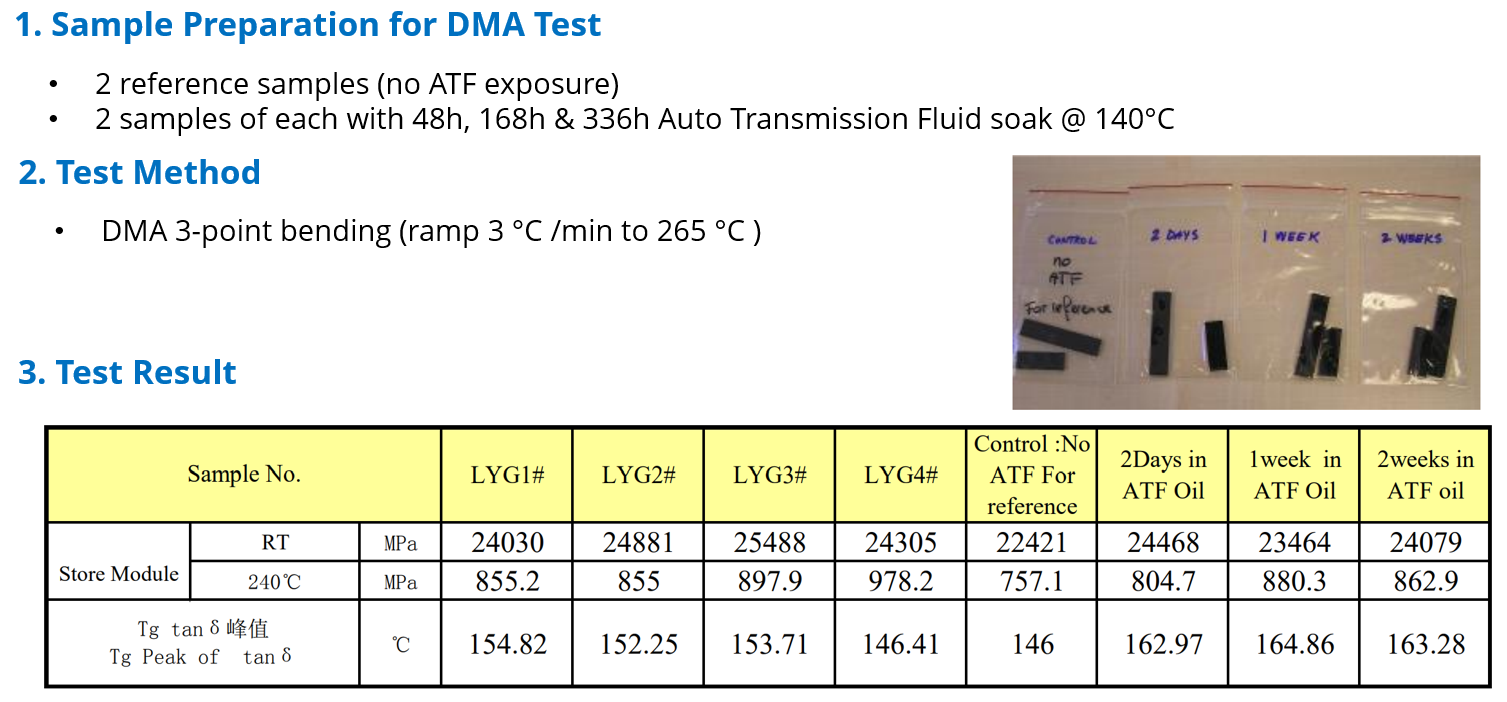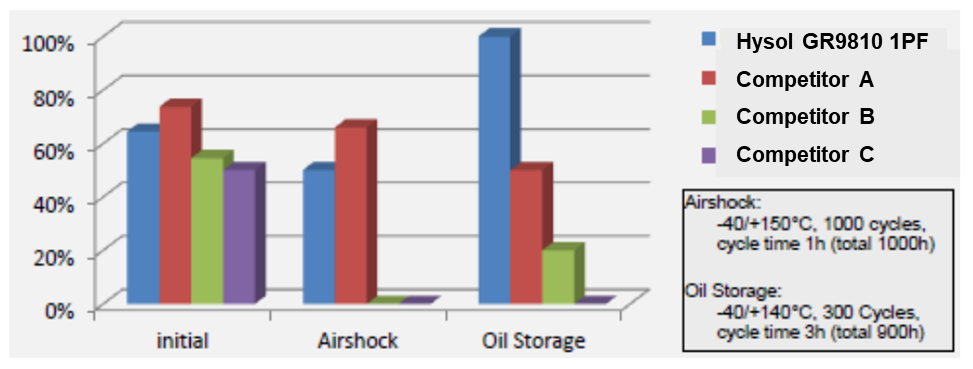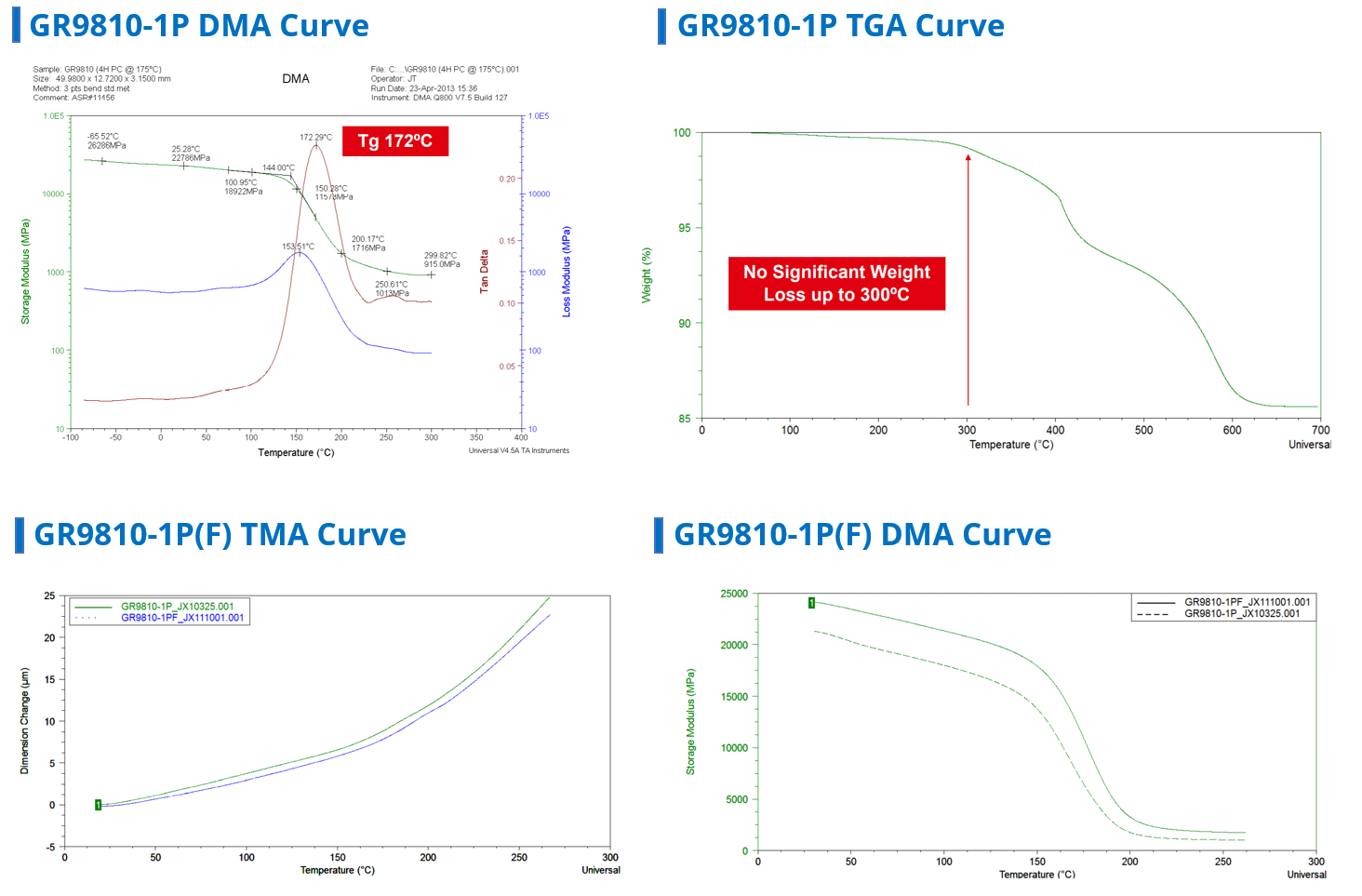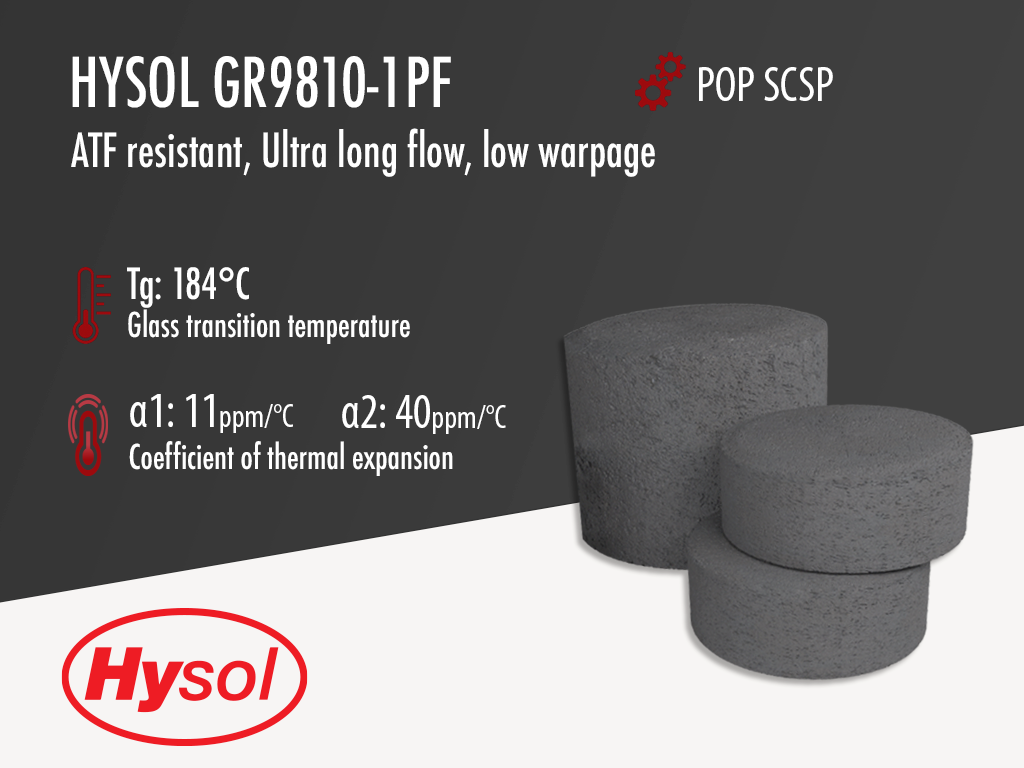Hysol GR9810-1PF | Black Epoxy Mold Compound
- Ultra long flow
- Ultra low warpage
- ATF Resist
Product Description
Hysol GR9810-1PF is a heat curable, state of the art, black, semiconductor epoxy molding compound developed to meet the stringent encapsulation requirements of package on package (POP and SCSP). It is a Green, halogen free product with, excellent dimensional stability, very low mold shrinkage and High Tg. Its chemistry allows for properties that go far beyond the "Standard Green" compound ranges.
Hysol GR9810-1PF and its related product GR9810-1P offer a new technology platform on which Hysol develops epoxy mold compounds for high reliability sensors and modules. Key features of GR9810-1PF are summarized as below.
Reliability
- Improved adhesion promoter and toughening system
- High filler loading (>86%) for lower moisture uptake
- Reduced moisture uptake for best MSL performance (MSL1-3)
Warpage Control
- Multifunctional resin hardener system with high Tg
- High cross-linking degree with special toughening system
- High filler loading for low CTE to minimize thermal mismatch
- High performance stress modifier to reduce internal stress
Wire Sweep Control
- Optimized filler PSD with 75um (-1P) or 45um (-1PF) filler cut
- Low viscosity resin and latent catalyst for ultra long flow
Hysol GR9810-1PF is developed for advanced reliability control. The goal of this technology platform is to introduce an epoxy mold compound capable of passing MSL1 260°C on some devices and at least MSL3 260°C on a stacked CSP (PoP) devices. The benefits do not stop here since this product is resistant to ATF (Automatic transmission fluid) and exhibits ultra low warpage making it an excellent choice for automotive packages. Check reliability test results and typical applications in automotive electronics.
Technical Specifications
| General Properties | |||||||
| Color Color The color | Black | ||||||
| Filler Content | 86 % | ||||||
| Specific Gravity Specific Gravity Specific gravity (SG) is the ratio of the density of a substance to the density of a reference substance; equivalently, it is the ratio of the mass of a substance to the mass of a reference substance for the same given volume. For liquids, the reference substance is almost always water (1), while for gases, it is air (1.18) at room temperature. Specific gravity is unitless. | 1.95 | ||||||
| |||||||
| Physical Properties | |||||||
| Spiral Flow @ 175°C | 170 cm | ||||||
| Chemical Properties | |||||||
| Moisture absorption | 0.40 % | ||||||
| Mechanical Properties | |||||||
| |||||||
| |||||||
| Molded Shrinkage | 0.15 % | ||||||
| Thermal Properties | |||||||
| |||||||
| |||||||
| Glass Transition Temperature (Tg) Glass Transition Temperature (Tg) The glass transition temperature for organic adhesives is a temperature region where the polymers change from glassy and brittle to soft and rubbery. Increasing the temperature further continues the softening process as the viscosity drops too. Temperatures between the glass transition temperature and below the decomposition point of the adhesive are the best region for bonding. The glass-transition temperature Tg of a material characterizes the range of temperatures over which this glass transition occurs. | 184 °C | ||||||
| Thermal Conductivity Thermal Conductivity Thermal conductivity describes the ability of a material to conduct heat. It is required by power packages in order to dissipate heat and maintain stable electrical performance. Thermal conductivity units are [W/(m K)] in the SI system and [Btu/(hr ft °F)] in the Imperial system. | 0.9 W/m.K | ||||||
| UL 94 Rating UL 94 Rating Flammability rating classification. It determines how fast a material burns or extinguishes once it is ignited. HB: slow burning on a horizontal specimen; burning rate less than 76 mm/min for thickness less than 3 mm or burning stops before 100 mm V-2: burning stops within 30 seconds on a vertical specimen; drips of flaming particles are allowed. V-1: burning stops within 30 seconds on a vertical specimen; drips of particles allowed as long as they are not inflamed. V-0: burning stops within 10 seconds on a vertical specimen; drips of particles allowed as long as they are not inflamed. 5VB: burning stops within 60 seconds on a vertical specimen; no drips allowed; plaque specimens may develop a hole. 5VA: burning stops within 60 seconds on a vertical specimen; no drips allowed; plaque specimens may not develop a hole | V-0 | ||||||
| Curing Conditions | |||||||
| |||||||
| |||||||
| Transfer Pressure | 90 kg/cm2 | ||||||
| Transfer Time | 15 - 20 s | ||||||
Additional Information
GR9810-1PF For Automotive Electronics Application
GR9810-1PF shows high reliability, good oil resistance, and excellent temperature recycling performance. GR9810-1PF is highly suitable for automotive electronics encapsulation. The key application advantages of GR9810-1PF:
- Under investigation in transmission control unit application to replace current complex sealed housing designs
- Used in a variety of applications including mobile devices
- Have high Tg (>180°C), low stress, and warpage control
- Ensure long-term reliability against automotive fluids
- Reduce footprint, space, weight, and cost
The ATF resistance results show no negative effect on Tg value and storage modulus of GR9810-1PF after 2 weeks ATF 140°C exposure.
GR9810-1PF ATF Resistance Test


GR9810-1P(F) Data Curves

Comparison with GR 9810-1P
Property / Product | Unit | Hysol | Hysol |
UNCURED PROPERTIES |
| ||
Hot Plate Gel time, @ 175°C | s | 32 | 40 |
Spiral Flow @ 175°C | in | 60 | 67 |
Flammability |
| V-0 | V-0 |
Halogen-free (Green) | ✔ | ✔ | |
Shelf Life @ 5°C | months | 12 | 12 |
TYPICAL CURED PROPERTIES |
| ||
Specific Gravity, g/cc | g/cc | 1.95 | 1.95 |
Glass Transition Temperature | °C | 170 | 184 |
Coefficient of Thermal Expansion (CTE) |
| 11 | 11 40 |
Flexural Strength, @25°C | MPa | 137 | 119 |
Flexural Strength, @240°C | MPa | 19.6 | 19.6 |
Flexural Modulus (E), @25°C | GPa | 20.6 | 20.6 |
Flexural Modulus (E), @220°C | GPa | 2.26 | 2.26 |
Moisture Absorption, 24hr PCT | % | 0.27 | - |
Mold Shrinkage, as molded | % | 0.10 | 0.15 |
Thermal Conductivity | W/mK | 0.9 | - |
Summary |
| ||




